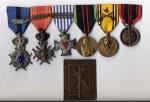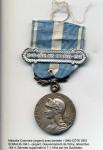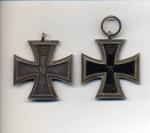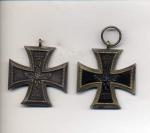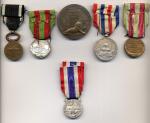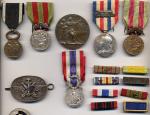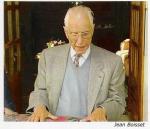-
Posts
2,284 -
Joined
-
Last visited
-
Days Won
6
Content Type
Profiles
Forums
Blogs
Gallery
Events
Store
Everything posted by PKeating
-

Belgium Question on Order of Leopolds
PKeating replied to Tim B's topic in Northern European & Baltic States
Here is an example of an award to a 'civilian', who spent three and a half years in German custody for Resistance activities. These medals were in a frame, which was beyond repair, but the recipient's name is lost in the mists of time and history, sadly. Interesting that he also received the French Resistance Medal. PK -
Nice Colonial Medal posted by Ulsterman, medal and bar clearly struck on the same dies as mine. The "tuna can" appearance or the bars suggests that these are wartime Vichy reissues of the bar awarded for service in the region between 1934 and 1937. The institution in December 1942 of the 1940-1941-dated bar was presumably to define the difference between earlier and later recipients, which would of course explain why the bar was not outlawed by the Gaullists. One wonders if any military personnel awarded the bar by the Vichy government wore it after the war. My example appears to have been worn, as the wear to the highlights and the the suspension system indicates. I really, really, really wish the 'picker' who found this pair had either enquired after documents or could be traced by the person from whom I acquired them with a view to following up any slight chance of finding paperwork. It is so typical here: grandpa's medals end up in the local antique shop while his papers and photos, if any, end up in the garbage, unless they are framed, in which case the next -of-kin or house-clearers are less likely to throw them away. Mind you, I know a fellow who rescued a St Helena Medal document from a rubbish skip (dumpster, in American parlance), along with several bundles of letters written home by the Grande Arm?e soldier when he was on campaign. Yup...they...were...thrown...in...the...trash. The medal and any other objects were presumably sold for the price of a Big Mac or a really greasy pizza by the retards clearing the house. Copyright ? www.france-phaleristique.com When new, the M?daille du M?rite de l'Afrique noire fran?aise, as it was also known, or the ?M?daille de Dakar? as it was nicknamed in reference to the Battle of Dakar in 1940, was light in colour, with a lacquered finish, like other French medals of the period. There must be documents out there, slipped into files and other papers. The Battle of Dakar took place from 23.9.1940 to 25.9.1940, when British forces implementing Operation Menace attacked the Senegalese port of Dakar, then part of French West Africa with the aim of installing a Free French administration. Vichy forces resisted strongly and the British and Free French were forced to withdraw. The M?daille du M?rite de l'Afrique noire fran?aise was also awarded to Vichy soldiers and civilians who distinguished themselves defending Madagascar against British and Commonwealth forces between May and November 1942, although Vichy lost that battle in the end once the British came ashore. This medal and the 1944 ?tat Fran?ais Croix de Guerre were the only medals officially instituted for military bravery or merit by the Vichy government.
-
I've shown these elsewhere in this section but they also fits into this thread as a logical follow-on from the Vichy 1940 C?TE DES SOMALIS 1941 Colonial Medal preceding this post. Although there was no documentation with them, as is so often the case with French medals, these two medals came from the same source and there is no reason not to assume that they were probably awarded to the same man. This Colonial Medal appears to be a non-French striking and is as-issued, with the C?TE DES SOMALIS bar instituted by the Vichy government on 13.9.1941 for a period of six months of unblemished service ? no chasing local girls or being drunk on duty ? from 25.6.1940, when French Somalialand declared itself loyal to the French government in Vichy. Following the British occupation of Italian East Africa in November 1941, the Royal Navy allowed Vichy ships through to resupply the garrison in Djibouti, which annoyed General de Gaulle, who felt that, under pressure, French Somalialand might rally to his cause. Vichy forces in French Somalialand held out for more than a year, until December 1942, when British and Free French forces occupied Djibouti and the rest of the colony following a three-month blockade by the Royal Navy. Vichy also issued a 1940 C?TE DES SOMALIS 1941 bar, intended as a replacement for the C?TE DES SOMALIS bar. The 1940 C?TE DES SOMALIS 1941 bar was outlawed by the January 1944 CLN decree from London. However, the C?TE DES SOMALIS bar seems to have escaped the Gaullist interdiction. The nice thing about this example of the M?daille du M?rite de l?Afrique Noire (Black Africa Merit Medal), which is an extremely scarce item, is that it was clearly worn by its recipient, who cut off a little piece of the riband to make himself a ribbon bar. Instituted by the Vichy government on 26.6.1941, this rather nice-looking decoration was awarded to white and black soldiers alike for bravery in combat against British and Gaullist forces in French Equatorial Africa, Madagascar and Somalialand. The Gaullist Comit? de Lib?ration Nationale in London outlawed the Medal of Merit of Black Africa along with other Vichy decorations and service medals on 7.1.1944. Struck in bronze and appropriately hallmarked on its rim, the medal was also awarded for distinguished or loyal service.
-
Although there was no documentation with them, as is so often the case with French medals, these two medals came from the same source and there is no reason not to assume that they were probably awarded to the same man. The nice thing about this M?daille du M?rite de l?Afrique Noire, which is an extremely scarce item, is that it was clearly worn by its recipient, who cut off a little piece of the riband to make himself a ribbon bar. Instituted by the Vichy government on 26.6.1941, this rather nice-looking decoration was awarded to white and black soldiers alike for bravery in combat against British and Gaullist forces in French Equatorial Africa, Madagascar and Somalialand. The Gaullist Comit? de Lib?ration Nationale in London outlawed the Medal of Merit of Black Africa along with other Vichy decorations and service medals on 7.1.1944. Struck in bronze and appropriately hallmarked on its rim, the medal was also awarded for distinguished or loyal service. The Colonial Medal appears to be a non-French striking and is as-issued, with the C?TE DES SOMALIS bar instituted by the Vichy government on 13.9.1941 for a period of six months of unblemished service ? no chasing local girls or being drunk on duty ? from 25.6.1940, when French Somalialand declared itself loyal to the French government in Vichy. Following the British occupation of Italian East Africa in November 1941, the Royal Navy allowed Vichy ships through to resupply the garrison in Djibouti, which annoyed General de Gaulle, who felt that, under pressure, French Somalialand might rally to his cause. Vichy forces in French Somalialand held out for more than a year, until December 1942, when British and Free French forces occupied Djibouti and the rest of the colony following a three-month blockade by the Royal Navy. Vichy also issued a 1940 C?TE DES SOMALIS 1941 bar, intended as a replacement for the C?TE DES SOMALIS bar: <a href="http://gmic.co.uk/index.php?s=&showtopic=3742&view=findpost&p=346926" target="_blank">http://gmic.co.uk/index.php?s=&showtop...st&p=346926</a>. The 1940 C?TE DES SOMALIS 1941 bar was outlawed by the January 1944 CLN decree from London.
-
For everyone's general interest, in the light of this discussion, here is a rather good article on the Army Balloon Badge by the late W C Stump, who sent it to me for proof-reading. This is just as he sent it. It is worth recalling for the simple reason that as well as fakes of accredited medals and badges, we are now facing attempts to introduce or 'rehabilitate' high end fakes and fantasy pieces, as the recent "Rounder" Knight's Cross affair showed us. We have also seen attempts - involving the same shills who figured in the Rounder affair - to convince newer generations of collectors that well-made 1960s Condor Legion Tank Badges (a small run probably commissioned by the veterans' association) are wartime pieces because of their resemblance to a retouched photo in a wartime catalogue. Someone has produced and aged some convincing-looking zinc "November 1944" Luftwaffe combat badges, complete with late war-style cardboard boxes. And desktop publishing technology has seen a rise in fake paperwork and 'enhanced' original paperwork, with a lot of the best examples coming from the Hamburg area. Some of these fake documents have been good enough to almost catch out some highly experienced collectors. So read Bill Stump's study of the Army Balloon Badge and bear in mind that with the massive interest in Third Reich memorabilia since 1945, it is highly unlikely that any great new discoveries will be made now. Were this group genuine, we would have seen other such award documents or credible entries in paybooks before now. Fakers favour units like the "Hermann G?ring" because so many of its members ended up in Soviet captivity. It's a bit like the documents one sees from time to time, purporting to be from members of Fallschirmj?ger-Bataillon "Brandenburg", recently discovered in former Soviet archives. I am surprised that this grouping did not have an "ex-Soviet Union" provenance. Perhaps it will acquire such a provenance for its next outing. Some of you might find this thread, on another forum, illuminating: http://www.feldgrau.net/forum/viewtopic.ph...=a&start=30 PK
-
Of course not. Another thing one has to bear in mind is that not a single credible researcher or collector who has met veterans of Luftwaffe ground forces, be they Fallschirmj?ger, LW-Feld-Division or "Herman G?ring" Division/Korps, has encountered anyone who was awarded or recalls any comrades being receiving a Luftwaffe Close Combat Badge, a Luftwaffe Sea Battle Badge, Luftwaffe numbered Ground Assault Badges or Luftwaffe Tank Battle Badges. It is rather like the Army Balloonist Badges or the Low Flying Aircraft Destruction Badges. Concerning the latter, some veterans put up 1957 ribbon bar versions to mark their award of the General Assault Badge for this feat of arms but they were not serving in the Bundeswehr when they did so and taking this liberty was akin to Royal Air Force ground crew veterans wearing the "Battle of Britain" bar on their 1939-1945 Stars at rallies after the war. They may have deserved the distinction but they never received it. There were Luftwaffe men, including Hermann G?ring, who felt resentful about the lack of Luftwaffe badges to recognise certain achievements. This is why Hermann G?ring instituted these badges in November 1944. A few convincing-looking examples have appeared on the market from time to time and there are also some 1957-style versions but it is highly unlikely that any such badges were available before 9.5.1945. This is not unusual: The Warsaw Shield was instituted in December 1944 and never saw a soldier's arm. The Lappland Shield was instituted in February 1945 but had to be produced locally as no official versions were forthcoming. In the case of the Lappland Shield, awards and documentation thereof possible because the units in question had more time on their hands than their comrades on the Western, Eastern and Southern Fronts. The one or two Luftwaffe groups involving October 1944 badges that were convincing enough to find their way into advanced collections in the past few years found their back out of those collections very quickly indeed once they were subjected to very close scrutiny. Coming back to the Hahlweg group, I haven't yet asked George Petersen, who is one of the foremost authorities on the "Hermann G?ring" in all its forms, but I have asked a few other people to check their files and we keep coming back to this slightly awkward lack of a Begleit-Kompanie on the ORBAT, as well as signatures that raise one or two eyebrows. Minor clerical errors are one thing but if there was no Escort Company on the books, one cannot really see Lieutenant-General Schmalz or his Corps Adjutant signing a document to a man in a non-existent unit! I think this is a case of someone building a group around a genuine document, based on some of the research - well, let's call it recapitulation in my case - I did for my above posts and not quite getting it right. Close, but no banana, as one might say. Were this group absolutely unquestionable, it would have found eager buyers in the top echelons of collecting, unless it had an utterly outrageous reserve price on it. Obviously, the serious HG collectors had doubts. As I said, it would be great if this group turned out to be genuine but the odds are very much against it, for the reasons outlined here. PK
-
Yup, larger scan, please. Or transcription. PK
-
http://gmic.co.uk/index.php?showtopic=3730...t=0#entry347835 A stranger is asking about this medal or medallion, which is Portuguese, possibly Masonic, but bears a dedication related to the Battle of Guadalajara in 1937. It also has a serial number, suggesting other awards so perhaps a student of Spanish Civil War memorabilia might recognise it. It could be a cleverly-done fantasy piece but it could just as well be a rare semi-official or unofficial item. PK
-
This prompted a bit of recapitulation regarding the 1a designation in the Luftwaffe command structure. 1a Chef des Stabes 1a Op 1 Operation Offizier 1a Op 2 Adjutant Operation Offizier 1b Adjutant The Flak-Kampfabzeichen and PKA d. LW documents are signed by officers described both as "1a" and "Adjutant". With reference to Simon's post, I don?t really see how I am arguing for the LW Tank Badge document by exploring the genealogy of Fallschirm-Panzer-Korps ?Hermann G?ring?. I have not yet been able to find any reference to a Begleit-Kompanie but I did find the following OBB of the FPK HG, reproduced below, which does list a Begleit-Bataillon ?Reichsmarschall?. I. Generalkommando: Kommandierender General: Generalleutnant und ELT Wilhelm Schmalz Chef des Stabes: Oberstleutnant (Heer) Bern von Baer (6.10.1944 - 8.5.1945) [baer was therefore the 1a of FPK HG] 1a: Major Werner Ebel (1.5.1945) [PK note: misprint? Surely 1b?) II. Korpstruppen: Korps-Sturmbataillon HG Korps-Panzerj?gerabteilung HG Korps-Nachrichtenabteilung HG Fallschirm-FlakRgt. HG (4 Abteilungen) I. Nachschubateilung HG II. Instandsetzungsabteilung HG Verwaltungsbataillon HG: Korps-Sanit?tsabteilung HG Korps-Feldpostamt HG III. Fallschirmpanzerdivision 1 HG: Divisionskommandeur: Generalmajor von Necker ab Febr. 1945: Generalmajor Lemke Divisionstab FschPzRgt. HG (2 Abteilungen) FschPzGrenRgt. 1 HG (2 Batl.) FschPzGrenRgt. 2 HG (2 Batl.) FschPzF?sBatl. 1 HG FschPzAA 1 HG FschPzPiBatl. 1 HG FschPzArtRgt. 1 HG (3 Abt.) FschPzNachrAbt. 1 HG FeldErsBatl. 1 HG SanAbt. 1 HG Feldpostamt 1 HG IV. Fallschirmpanzergrenadierdivision 2 HG: Divisionskommandeur: Generalmajor Walther Divisionsstab FschStGeschAbt. HG FschPzGrenRgt. 3 HG (3 Batl.) FschPzGrenRgt. 4 (3 Batl.) FschPzF?sBatl. 2 HG FschPzAufklAbt. 2 HG FschPzArtRgt. 2 HG (3 Abte.) FschPzNachrAbt. 2 HG Feldersatzbatl. 2 HG Sanit?tsabteilung 2 HG Feldpostamt 2 HG V. Sonstige Verb?nde und Dienststellen: F?hrerFlakAbt. (nur noch in der ersten Zeit) Begleitbataillon "Reichsmarschal" FschPzErs. u. AusbBrigade HG mit den Regimentern 1 und 2 (bis M?rz 1945) Brigadekommandeur: Major Ilius ab Nov. Oberst Meyer FschPzErs. u. AusbBrig. 2 mit den Regimentern 3 und 4 (ab M?rz 1945) Brigadekommandeur: Oberst Breuer ab April 1945: Gen. d. FschTr. Br?uer Ers. u. AusbRgt. HG in Hollan Heimatstab FschPzKorps HG, Berlin-Reinickendorf Leichtkranken-Lazarette (Erholungsheime) in Oberau u. Reit i. Winkel) The Begleit-Bataillon "Reichsmarschall? was formed on 5.1.1945 and comprised: 1.Grenadier-Kompanie 2. Flak-Batterie 3. Grenadier-Ausbildungs-Kompanie 4. Grenadier-Ausbildungs-Kompanie 5. Kraftfahr-Ausbildungs-Kompanie 6. Kraftfahr-Ausbildungs-Kompanie 7. Versehrten-Kompanie The 12.2.1944 Flak document, apparently signed by Major Oskar Niehoff, refers to this Begleit-Kompanie. Perhaps there was a Begleit-Kompanie on the Korps strength at the time but I have been unable to find any reference to it. As for the Tank Badge document, we know that there are plenty of German documents containing clerical errors. Assuming that there was a Begleit-Kompanie on the Korps OBB at some point between October 1944 and early January 1945, perhaps the clerk who prepared the document was working from a Wehrpa? or a Soldbuch that had not been updated. The Begleit-Btl ?Reichsmarschall? was disbanded late in March 1945. So it was no longer on strength when Hahlweg was allegedly awarded the Panzerkampfabzeichen der LW. This begs the question: why would the Korps retain any Reichsmarschall-related escort sub-unit on strength after March 1945? On 24.4.1945, Hermann G?ring was under house arrest in the Obersalzburg, a long way from the Korps bearing his name, following his attempt to declare himself F?hrer. I?m sorry, guys, but this grouping just doesn?t hang together convincingly for me. I suspect that it is a genuine group ?enhanced? by the addition of some quite well done fakes, that would fool the average collector but fail to stand up to serious scrutiny. Perhaps I am wrong. Perhaps it is all genuine. But there are just too many anomalies. it reminds me of a cleverly executed SS-Fallschirmj?ger grouping, where the faker had used genuine blank documents, period typewriters and so on, and had placed the man more or less in the right places but at the wong time. Moreover, he had given the man too special a rank and this helped to debunk the grouping, which had cost a collector a lot of money. Another problem concerns the EK2 document. The signature is very convincing, the green chinagraph notwithstanding. Like Felix Steiner, Wilhelm Schmalz liked to use chinagraph mapmarkers when signing award documents. Perhaps he was all out of blue chinagraphs. Anyway, that's a side issue. It has been pointed out that the same typewriter was used on the EK2 and PKA d. LW documents. That's fine, but the omission of "den" suggests different typists. Fine, no problem with that. But the awards on the same day would suggest a link. Perhaps Schmalz and his officers felt, imminent defeat aside, that the days of their Korps were numbered, given the arrest of G?ring. Departing commanders often caught up on overdue awards before they left. If Generalleutnant Schmalz was signing award documents on 26.4.1945, surely the two documents to Obergefreiter Hahlweg awaiting signatures and stamps would have been presented to Schmalz together? Moreover, the award of even a figurative PKA d. LW would have been quite a special occasion. Sure, from the average fellow's viewpoint, this all looks great. The stamps look right. The signatures are convincing. Etcetera?etcetera?etcetera? But it just doesn?t hang together. The elements are all there but sewn together like Frankenstein?s monster. Very cunning trap! Flak?Begleit?Begleit-Kompanie... Were the Flak document to IV./Fallschirm-Flak-Rgt ?Hermann G?ring? and the Tank Badge document to 2./Begleit-Btl ?Reichsmarschall? or 2./Begleit-Btl./Fallschirm-Panzer-Korps "Hermann G?ring", perhaps in March rather than April 1945, the grouping would be even more dangerous than it already is. I'm inclined to believe the Wound Badge document and, perhaps, the Flak Badge document, if it can be shown that there was a Begleit-Kompanie on the OBB of FPK HG at the end of 1944. There might have been. It might have been the cadre sub-unit for the formation of Begleit-Btl "Reichsmarschall". I might even believe the EK2 document, were it not for the fact that the same typewriter appears to have been used for this document and for the Tank Badge document. PK
-
Let's see if we can unravel this. Fallschirm-Panzerkorps "Hermann G?ring" was really an administrative entity, established in Poland in September and October 1945 to support Fallschirm-Panzer-Division 1 "Hermann G?ring" and Fallschirm-Panzergrenadier-Division 2 "Hermann G?ring". Fallschirm-Panzerkorps "Hermann G?ring" was formed with elements of Fallschirm-Panzer-Division "Hermann G?ring" as cadre. A few days later, Fallschirm-Panzer-Division "Hermann G?ring" was retitled Fallschirm-Panzer-Division 1 "Hermann G?ring. Maybe my reference is incomplete but I cannot see a Begleit-Kompanie on the OBB of FPK HG. The only references to Begleit units that I can find in HG genealogical tree are the Begleitkompanie (z.b.V.), which was part of the Stab/Panzer-Division HG in 1943, and the Begleit-Rgt HG, formed from the Wachregiment "Hermann G?ring" in April 1944. Begleit-Rgt HG's OBB included the II.(Flak) Abt, which was became IV./Fallschirm-Flak-Regiment HG in September 1944. Brought under Corps control in October, Fsch-Flak-Rgt HG became Fallschirm-Panzerkorps Flak-Regiment HG. Obergefreiter Hahlweg may have served in the Flak Detachment of the Begleit-Regiment "Hermann G?ring", thereby earning the Flak Badge. Elements of the Flak being motorised, on armoured tracked vehicles, Hahlweg might have qualified for the Panzerkampfabzeichen der LW in Schwarz at some point, the Adjutant's office making sure that personnel received their due awards before the end of the war, which was obviously imminent by 26.4.1945. As we know, like any official documents, German documentation can and does contain errors and anomalies, especially with clerks referring to Wehrpa?e which may not have been efficiently updated. Did Hahlweg once serve in the Begleitkompanie (z.b.V) in the Panzer-Division HG in Italy in 1943? Or was he a Wachregiment veteran, who had served with the Flak Detachment of the Begleit-Regiment HG before ending up in the Korpstruppe of the Fallschirm-Panzerkorps "Hermann G?ring", in the Fallschirm-Panzerkorps Flak-Regiment HG? Whatever the case, I see no Begleitkompanie on the OOB of either Fallschirm-Panzerkorps HG or Fallschirm-Panzer-Division 1 "Hermann G?ring. Furthermore, the signature on the Flak Badge document can be seen on Panzer-Division HG award documents signed late in 1943 by the divisional 1a, whose name escapes me presently, who was then a Hauptmann and Adjutant under Paul Conrath. Was this officer, promoted Major by december 1944, the Adjutant of Fallschirm-Panzerkorps "Hermann G?ring"? And given that Fat Hermann wasn't to be found anywhere near the areas of operations of the divisions bearing his name towards the end of the war, why would the Fallschirm-Panzerkorps "Hermann G?ring" have included a Begleitkompanie "Hermann G?ring" on its OBB in the first place? Questions, questions, questions... Let me put it this way: I wouldn't buy these documents based on what I am looking at here. I will, to quote the late William Stump, "eat crow" if proven wrong but they look like clever fakes produced by someone with a little knowledge, which is always a dangerous thing. Moreover, I have never seen a convincing document of any kind related to the award of Luftwaffe Tank Badges, Sea Battle Badges, Close Combat Clasps or numbered Ground Assault Badges. PK
-
Try again! One of the Vichy-issue bars. On Hendrik's fascinating website, there are two variants of this bar shown, the first being this type and a second with the dates below the legend C?TE DES SOMALIS. This bar was outlawed by the Gaullist decree of 7.1.1944.
-

EK 1914 1914 EKII in brass!
PKeating replied to Motorhead's topic in Germany: All Eras: The Iron Cross
I hadn't thought of neu-silber. Thanks, Greg. I would say that these two crosses are struck in neu-silber. PK -
I feel grand! Thanks, though! Regarding the Odette link, Odette Sansom and her future husband Peter Churchill were captured within a few hours of Churchill's parachute landing on the Semnoz plateau on 15.4.1944, Boisset himself did not join the Maquis until the following month, according at any rate to the citation, which does contain errors, but, yes, given that Odette was with the Semnoz Maquis, there is certainly a link as many of the men who served with Boisset would have known Odette. Jean Boisset would appear to have run into German troops participating in Operation Fr?hlung against, primarily, the Ain Maquis. Beginning on 7.4.1944 and ending on 18.4.1944, Fr?hlung was carried out by 157. Reserve-Division, assisted by units attached for the operation. Boisset and his men may have run into elements of Gebirgsj?ger-Ersatz-Regiment 1, namely Reserve-Gebirgsj?ger-Btl. I./98 or 99, whose overlapping areas of operations covered Semnoz. It should be noted that Gebirgsj?ger-Ersatz-Regiment 1 had nothing to do with 1. Gebirgs-Division. When 157. Reserve-Division and supporting units launched Unternehmen Fr?hlung, Colonel Romans-Petit ordered his units to disperse, in line with his sensible policy of avoiding direct engagement where possible with enemy forces, a policy observed by special forces and insurgents in many conflicts. However, the Maquis still carried out acts of sabotage and nocturnal hit-and-run attacks against the Germans, whose reprisals against local villagers were quite savage. 157. Reserve-Division, which took part in other anti-partisan or "anti-terrorist" operations, including Vercors, was redesignated 8. Gebirgs-Division in March 1945. It was the only Wehrmacht division deployed continuously against partisans for more than a year. Although some of the division's sub-units were accused of war crimes, the divisional commander, Generalleutnant Karl Pflaum, disapproved of the excessive cruelty of Sicherheits-Polizei and SD units in the area and many French historians contend that the 157th Reserve Division actually behaved far better in the field than some recent accounts suggest, despite the fact that the division was essentially under SD control. Nevertheless, Generalleutnant Pflaum was imprisoned for more than four years by the French. PK
-

EK 1914 1914 EKII in brass!
PKeating replied to Motorhead's topic in Germany: All Eras: The Iron Cross
Here are a couple of one-piece or ersatz EK2 1914 I have had for a long time. They're struck on the same set of dies but one is unfinished. The finished example seems to be stove-enamelled. The strike is, as you can see, of very quality. They look a bit like nickel but that would have been a restricted resource so I'd hazard a guess that they are of good quality plated brass, judging by the ringing sound when tapped gently against a wooden surface. PK -
Thank you very much, Paul. PK
-
Hallo, Can anyone tell me anything about these badges? The badge on the top is in silver, of two-piece construction with a screw-back fitting. I've included a scan of the hallmarks. The lower badge is of bronze, screw-back, with the imperial eagles and the crown double-sided and of multi-piece contruction, with seven tiny, very neat rivets holding the flaming grenade, the wreath and imperial monograms in place. Thank you in advance, PK
-
I realised that he was more than rank and file because of the reference to "his men" but had no idea that he was a Maquis chieftan. I was also stunned that he had survived Buchenwald and was very moved by the reference to his ruined health and the evident difficulty the authorities had in locating him afterwards. Troubled war veterans is something of a theme for me, for want of a better way of putting it, and once Boonzaier sent me the link and I saw the documents, I was blown away. I knew about Romans Petit. That this ensemble was addressed to Romans Petit left me rather awestruck as well. As you said, real Resistance heroes. These chaps were out there in the ulu before it became fashionable or advisable. P
-
This lot came from the same source, a chap involved in house clearances. Part of a family group, perhaps. G Grattard was honoured by the railwaymen's union and the Ministry of Public Works. He also got a non-portable medal for military physical training and seems to have been quite highly decorated in WW1, if the ribbon bars have anything to do with him. Constant Pilaud was perhaps a relative. Maybe a son received the WW2 Croix de Guerre. Perhaps Grattard received it, along with the Resistance Medal. It is certainly worthy of some research. As is so typical of groups like this in France, any papers are missing. Time and time again, I come across the most fascinating groups of medals and insignia, often sold off by junior relatives of the deceased who have usually thrown the papers, photos and so on in the trash because they do not understand their significance. PK
-
Some more information about Semnoz: http://loprazcondus.canalblog.com/archives...02/6750351.html Semnoz. The lake of Annecy seen from the top of Semnoz. A couple of weeks before Boisset joined them, the Semnoz Maquis had been with Odette Sansom when her future husband Peter Churchill was dropped on the Semnoz on April 15th 1943. A few hours later, they were both captured. In April 1944, Jean Boisset and his men probably found themselves fighting sub-units of SS-Polizei Regiment 19, later assigned as bodyguards to the fleeing Vichy government and Marshall P?tain in September 1944. SS-Polizei Regiment 19 was particularly brutal and around eighty of its members taken prisoner by the Maquis paid the price in September 1944 when executed in retaliation for the unit's summary execution of Maquis prisoners and French civilians. PK
-
Henri Petit, alias Colonel Romans Petit, Chief of the Arm?e Secr?te in the Ain region and wrote Les Obstin?s, published by Janicot in 1945. Compagnon de la Lib?ration, Commandeur de la L?gion d?Honneur et Distinguished Service Order (UK). (French Government archives) The man to whom Jean Boisset's medal and document were entrusted, Henri Petit, son of a French railway executive, was born in 1897. In 1915, he volunteered and rose to sergeant in the 13e Bataillon de Chasseurs. He was made a Knight of the Legion of Honour and was also decorated with the Croix de Guerre with Bronze Palm. Commissioned through the Saint-Cyr officers' academy in 1918, he was posted to the B.R. 127 bomber squadron. Ending WW1 as a Sous-Lieutenant, he went back to college in Lyons and thence into public relations for publishing houses before founding the Stefa advertising agency in 1928. Recalled in 1939 as a Colonel of the Reserve in the Air Force, Petit commanded the Nice and Cannes airbases and refused to recognise the armistice in June 1940. Unable to reach London, he moved to the Ain region in 1942 where he established contacts with the local Resistance. By that December, Petit was in charge of finding safe lodgings for young men on the run from being sent to Germany and other parts of the Greater German Reich for forced labour. In June 1943, Petit had formed leadership and training schools and camps for Ain maquisards of the FFI and Arm?e Secr?te. Each camp comprised no more than sixty men to facilitate greater security and mobility. In September, under the command of Romans-Petit, the Ain maquisards raided and emptied a Vichyite Chantiers de la Jeunesse depot in Artemare and a military supply depot in Bourg-en-Bresse. Romans-Petit became chief of the Ain d?partement Arm?e Secr?te in October 1943. On November 11th 1943, he organised the famous - and illegal - ceremonial parade involving 250 AS and FFI men in the town of Oyonnax, laying a wreath in the form of a floral Cross of Lorraine at the war memorial in front of crowds of delirious townsfolk before marching out of the town at the head of his men in a highly professional show of military force. Remember, this was not after the D-Day landings. These men did this in a very hostile environment, where they were not only up against the Germans but a substantial proportion of their own countrymen, who saw them as brigands and threats to law and order and the pax germanica. The parade was filmed and reported by the underground press and the BBC in London, and was probably the point at which the Allies began to see the French Resistance as a force to be reckoned with...and respected. Early in 1944, the Ain Maquis counted some 2,000 men under arms, all well-trained in the use of automatic weapons, sabotage and guerrilla fighting. "Mobility is your strength", Romans-Petit told them, again and again and again. They were taught that their camps were not forts to be defended to the last man. If attacked, they had to slip away into the forests. Remember Boisset's citation, rewarding him, amongst other things, for leading his men to safety away from the German force attacking their mountain top redoubt in a grotto on the Semnoz peak. Romans-Petit also assumed command of AS forces in Haute-Savoie. In daily touch with the SOE in London, Romans-Petit designated the Gli?res plateau - familiar to all students of the French Resistance - as the DZ for arms drops in January 1944 before returning to the Ain. As the spring arrived, the Germans decided to tackle the Ain Maquis. 5,000 German soldiers and auxiliary Police and SS-Polizei units mounted an offensive against Maquis bases, killing hundreds of maquisards. Romans-Petit and others escaped on skis through German lines. On April 6th 1944, German forces launched an offensive in the area of Amb?rieu-en-Bugey, some 60km north-east of Lyons. Romans-Petit ordered his forces to disperse and go to ground. And so, the next day, Jean Boisset, commander of the Semnoz Maquis, was captured in the town of La Cluse as he and some of his men were heading back by a roundabout route to Semnoz, some 55km east of Lyons and about 10km south of Annecy. La Cluse lies about 25km to the north-east of Amb?rieu-en-Bugey. That he survived capture let alone Buchenwald is quite astonishing. For his citation to refer to his damaged health speaks volumes for the state in which he must have been when he was repatriated, as does the apparent inability of the authorities to find him in 1947 and again in 1950, when they eventually sent his Croix de Guerre ? l'Ordre de l'Arm?e and citation to his former commander, Henri Romans-Petit. And yes, I am going to order the DVD featuring the elderly Jean Boisset talking about his time as chief of the Semnoz Maquis! PK
-
Nah...boxing-related cranial trauma. One of the 30-plus lesions they found in my brain decided to react badly to the latest hard knock. But I don't have a lazy left eye anymore. Cue: Life of Brian: Always look on the bright si-i-de of life.... Anyway, whilst doing some research on the Semnoz Maquis the other day, I stumbled across this website: http://www.cc-pays-albysurcheran.fr/chapitre3_fr_35_37.html# Check out the entry about halfway down. As we know, Jean Boisset survived Buchenwald and it would appear that he regained his health sufficiently to live to a grand old age and to make recordings about his resistance activities. Here, below, is Jean Boisset, Professor of German and ex-Commander of the Semnoz Resistance. The internet can sometimes throw up surprising things...


